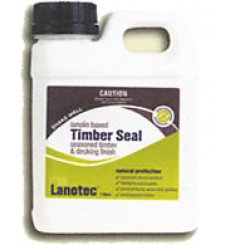Lanotec Timber Seal 1L
Lanotec Timber Seal 1L
Applying Timber Seal
Previously untreated timber should be treated against mould and/or fungus spores(use any quality broad spectrum agent) before applying Timber Seal.
Apply Timber Seal to all end grains, bearers, checkouts, end plates, bolts anddrill holes before assembly. To maximise protection from moisture and help reduceany future warping, twisting or splintering, spray all exposed surfaces.
After ensuring that the surface to be covered is clean and dry, apply light coats of Timber Seal using a mist spray or ideally, a flat lamb’s wool applicator.Allow a minimum of 6 hours between coats to allow the product to penetrate into the timber. Remember to “Let the timber do the talking” as the amount of coats you will need to apply will depend upon the timber’s absorption rate. If the timber is still tacky after 6 hours, a second coat is not required.
After the Timber Seal has fully penetrated into the timber and the carrier has evaporated, to avoid any tackiness, the timber must be rubbed or polished (eg with dry towelling or similar polishing cloth) to seal the wax and maximise the protective seal, highlighting your timber’s natural grain.
| Coverage Guide | ||
|---|---|---|
| Softwood | New | Approx 10-15m2/ltr |
| Softwood | Old | Approx 8-10m2/ltr |
| Hardwood | New | Approx 8-10m2/ltr |
| Hardwood | Old | Approx 6-8m2/ltr |
Useful hints for best results with Timber Seal
“Let the Timber do the Talking”
All timbers are different and will display different rates of absorption. E.g.hardwood is less absorbent then softwood. The coverage rate is especially reducedon very dry softwood. It is always a good idea to try the product on an inconspicuous area first.
Moisture content in timber will affect the penetration rate of Timber Seal and can cause a patchy colouring if the timber is not allowed to dry out completely.High levels of tannin and oily resins can also cause a patchy coloured effect so a clean, dry surface is important before application. Allow approximately six hours drying time between coats as a general guide.
General Hints
- Remove prior surface coating, algae & fungi deposits
- Apply lightly and sparingly to avoid wastage
- If the timber has turned grey due to weathering, sanding the surface to remove dead fibre allows Timber Seal to penetrate, highlighting timber’s natural grain.
- If the timber is freshly milled or “green” only apply Timber Seal inside joints and on bolts and fasteners allowing the timber to weather further before applying any coating systems
- If the timber surface has become dirty between applications, a light wash down with Citra-Force will restore the surface for further coats.
- Timber Seal and Timber Seal PLUS are best applied by spraying or, for decking surfaces, by a foam roller
- Knapsack or garden pump type applicators are suitable
- Compatible with most solvents and oil based paints, however we advise conducting an adhesion test with an off-cut or inconspicuous area first
PLEASE NOTE: Timber Seal is not compatible with water based acrylics.
Other features and benefits
- Easy and safe to use
- Non Toxic (Safe for the user)
- Acid resistant
- Reduces maintenance costs (extends life)
- Cleanup of worksite and spraying equipment is safe and easy with Lanotec’s Citra-Force
- Timber Seal can be applied to existing structures.
- The lanolin seals the timber making it weatherproof and waterproof.
- Not a beautification product – Timber Seal will not change the appearance of timber, aside from initially highlighting the grains within the timber. It will not prevent greying. It will protect the timber from damage caused by weather.
- Lanolin prevents seasoned timber from splitting and cracking through maintaining their natural internal moisture levels.


